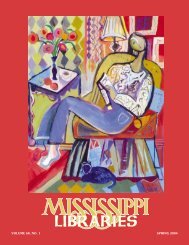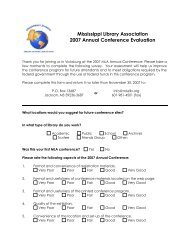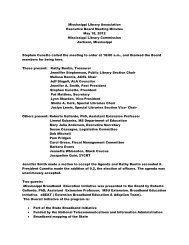Full Text (PDF) - Mississippi Library Association
Full Text (PDF) - Mississippi Library Association
Full Text (PDF) - Mississippi Library Association
You also want an ePaper? Increase the reach of your titles
YUMPU automatically turns print PDFs into web optimized ePapers that Google loves.
<strong>Mississippi</strong> Libraries Vol. 69, No. 4, Winter 2005 Page 96<br />
Katrina First-hand:<br />
A Report from William Carey College<br />
Patricia Furr<br />
Director<br />
William Carey College <strong>Library</strong><br />
The William Carey College campus in<br />
Gulfport was heavily damaged by the<br />
Hurricane Katrina storm surge and the<br />
library building was deemed a total loss.<br />
We first saw McMullen <strong>Library</strong> about<br />
ten days after the storm, as the area was<br />
deemed unsafe and inaccessible to nonrescue<br />
personnel before that time. Most<br />
of the roads were initially impassable and<br />
many of us were trying to cope with damage<br />
at our homes as well. When we finally<br />
made it down to the Gulfport campus,<br />
we had no idea what to expect.<br />
The bookstore at William Carey College on the Coast (foreground) was<br />
destroyed by Katrina. The Fairchild Administration Building (background)<br />
took the brunt of the storm and was deemed a total loss. Photo by Pat<br />
Yuen.<br />
The location of the library building is<br />
the third in line from the beach. The main<br />
administration building, located directly<br />
on the beach, took the brunt of the storm<br />
surge. The whole first floor of the solid<br />
brick structure was gutted. The college<br />
bookstore, located behind the administration<br />
building and in front of the library,<br />
completely collapsed. Those two buildings<br />
probably took much of the force of<br />
the wave and prevented more damage to<br />
the library.<br />
The library building itself remained<br />
intact, but the roof on the front section<br />
was missing and many windows<br />
were broken. The first thing we<br />
noticed when we entered the library<br />
building was the smell. The sewers<br />
had backed up through the bathrooms<br />
and onto the books that had<br />
been washed from the lower shelves<br />
onto the floor. The floor was covered<br />
with a semi-dry three-to-four inch coat<br />
of mud, sand, books, and sewage.<br />
There were overturned tables and<br />
heaps of debris with chairs, boards,<br />
library signage, etc. all swirled together<br />
in piles. It was an unbelievable<br />
sight.<br />
After making a sweep to check for<br />
hazards, we cleared<br />
some pathways. We<br />
had to be very careful<br />
not to step on the<br />
piles of trash, as<br />
they often contained<br />
nails and library<br />
shelves. I was not<br />
anticipating that anything<br />
would be<br />
recoverable, as<br />
mildew usually<br />
grows quickly in wet<br />
materials. When we<br />
made it back to the<br />
stacks, we were amazed<br />
to find that the books on<br />
the top four shelves of each section were<br />
clean and dry. Most, in fact, were pristine<br />
with not even a page ruffled. The only<br />
exceptions were those next to broken windows.<br />
We were puzzled and wondered why<br />
there was not a uniform growth of mildew<br />
over the entire collection, but believe the<br />
clean, dry shelves were a result of unusually<br />
low humidity for the first ten days<br />
after the storm. It was about 100 degrees<br />
in the building most of the four days we<br />
worked and a dry breeze occasionally<br />
The floor of the library was covered with a layer of mud,<br />
sand, sewage, and books. Photo by Pat Yuen.<br />
blew through the building. The broken<br />
windows also helped the air circulate in<br />
the building. We knew we had only a very<br />
short window of opportunity to recover<br />
the undamaged materials before the<br />
mildew would spread from the lower<br />
shelves, so we set to work quickly.<br />
We used gloves, long pants, alcohol<br />
and boots in an effort to remain clean.<br />
The smell and the flies generated by the<br />
sewage made it very tough to work.<br />
Masks quickly became wet from sweat<br />
and glasses fogged. In fact, it was so hot<br />
working in this environment that staff<br />
members’ clothing became completely<br />
(continued on page 99)














